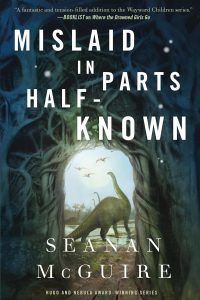Gary K. Wolfe reviews Genevieve Valentine
Persona, Genevieve Valentine (Saga 9781481425124, $24.99, 315pp, hc) March 2015.
Dream Houses, Genevieve Valentine (WSFA Press 978-1-936896-06-6, $25.00, 128pp, hc) October 2014.
 Well intentioned as it may be, the problem with praising someone as a promising new writer is that it seems to imply an undefined and unsolicited obligation: promising what, exactly, and who made the promise in the first place, and to whom? Genevieve Valentine has been publishing short fiction for seven or eight years now, and her Crawford-winning first novel Mechanique, vaguely redolent of steampunk but more so of Angela Carter, should fit anyone’s definition of a promising debut. But Valentine, along with Daryl Gregory, Karen Lord, and a few other novelists who have emerged in the last few years, has chosen unexpected turns for each of her follow-up novels. This, to my mind, is a healthy sign for a writer who wants to be a writer, though perhaps less so for a writer who wants to be a franchise. Instead of returning to the colorful world of the Circus Tresaulti for her second novel, Valentine chose to combine a sepia-colored Jazz Age New York with a clever fairytale redaction in The Girls of the Kingfisher Club, and now strikes out in entirely different directions again with both her new novel Persona and the novella Dream Houses. The former is a near-future espionage and political thriller, while the latter is set aboard an interstellar spaceship with a lone survivor. There’s not a post-apocalyptic circus or a dancing princess anywhere in sight in either story, but both deal with issues of trust and betrayal that were prominent in the earlier novels.
Well intentioned as it may be, the problem with praising someone as a promising new writer is that it seems to imply an undefined and unsolicited obligation: promising what, exactly, and who made the promise in the first place, and to whom? Genevieve Valentine has been publishing short fiction for seven or eight years now, and her Crawford-winning first novel Mechanique, vaguely redolent of steampunk but more so of Angela Carter, should fit anyone’s definition of a promising debut. But Valentine, along with Daryl Gregory, Karen Lord, and a few other novelists who have emerged in the last few years, has chosen unexpected turns for each of her follow-up novels. This, to my mind, is a healthy sign for a writer who wants to be a writer, though perhaps less so for a writer who wants to be a franchise. Instead of returning to the colorful world of the Circus Tresaulti for her second novel, Valentine chose to combine a sepia-colored Jazz Age New York with a clever fairytale redaction in The Girls of the Kingfisher Club, and now strikes out in entirely different directions again with both her new novel Persona and the novella Dream Houses. The former is a near-future espionage and political thriller, while the latter is set aboard an interstellar spaceship with a lone survivor. There’s not a post-apocalyptic circus or a dancing princess anywhere in sight in either story, but both deal with issues of trust and betrayal that were prominent in the earlier novels.
Persona is pointedly restrained in its use of SF invention. Brazil and Peru have joined to form the United Amazonian Rainforest Confederation, and Suyana Supaki represents them as their ‘‘Face’’ – a kind of camera-friendly but essentially powerless spokesperson, answerable to diplomat ‘‘handlers’’ – at a UN-like economic summit called the International Assembly. Papparazi, or ‘‘snaps’’, are equipped with what amounts to Google-glass implants (not so different from those in Simon Ings’s Wolves) which can continuously record whatever they see and hear, although the other central character, Daniel Park, prefers the old-fashioned camera. We barely have a moment’s breath to learn this, however, as Valentine launches us immediately into a nonstop action-movie scenario that begins with an attempted assassination that seriously wounds Suyana, details her flight through Paris with the assistance of Daniel (who was trying to get a picture of her at the moment of the gunshots), and develops into a dance of shifting loyalties and betrayals that calls into question not only who is trying to kill Suyana, but where her own true loyalties and those of Daniel lie. The narrative, broken up occasionally by bureaucratic photo-index descriptions and appointment schedules, efficiently touches all the bases of the classic paranoid thriller and gradually reveals unexpected depths in Suyana, Daniel, and some of their pursuers and would-be allies, but it’s never entirely clear what the reasonable but modest SF elements add to the novel.
 Dream Houses, on the other hand, opens as a classic SF mystery. Amadis Reyes, a low-level crew member on a seven-year supply run to one of the extrasolar planets of Gliese, emerges from her sleep-pod to find the other crew members dead, apparently of asphyxiation, and herself with insufficient supplies to keep her alive for the remaining years of the journey (she quite reasonably doesn’t want to go back into the pod). The ship’s AI, Capella, is amenable enough to chatting with Amadis, but when she asks what’s in the cargo hold – which shows up as empty on the video feed – the answer is a chillingly cryptic ‘‘invalid query.’’ This is familiar furniture that wouldn’t have been out of place in Planet Stories in 1950, but it’s not what makes the story remarkable. Instead, the space adventure – and we do get a few answers eventually – is primarily a frame for a far more complex and nuanced story involving Amadis’s childhood, her earlier career as a long-distance trucker, her passion for large-scale choral music (hence names like Amadis and Capella), and most of all her troubled lifelong relationship with her brother, who may or may not have ever truly loved her, and who played a crucial role in her decision to spend years of her life in space. In an odd way, the story this most reminds me of is Kelly Link’s similarly titled ‘‘Two Houses’’, in which a space voyage also frames more tragic and haunting tales that might have been told without the apparatus of SF at all. But the manner in which Valentine overlays these themes and voices, like an increasingly complex Renaissance motet, is masterful, and it makes Dream Houses, despite its familiar surface trappings, the most unexpected fugue on a space adventure that I’ve seen in quite a while.
Dream Houses, on the other hand, opens as a classic SF mystery. Amadis Reyes, a low-level crew member on a seven-year supply run to one of the extrasolar planets of Gliese, emerges from her sleep-pod to find the other crew members dead, apparently of asphyxiation, and herself with insufficient supplies to keep her alive for the remaining years of the journey (she quite reasonably doesn’t want to go back into the pod). The ship’s AI, Capella, is amenable enough to chatting with Amadis, but when she asks what’s in the cargo hold – which shows up as empty on the video feed – the answer is a chillingly cryptic ‘‘invalid query.’’ This is familiar furniture that wouldn’t have been out of place in Planet Stories in 1950, but it’s not what makes the story remarkable. Instead, the space adventure – and we do get a few answers eventually – is primarily a frame for a far more complex and nuanced story involving Amadis’s childhood, her earlier career as a long-distance trucker, her passion for large-scale choral music (hence names like Amadis and Capella), and most of all her troubled lifelong relationship with her brother, who may or may not have ever truly loved her, and who played a crucial role in her decision to spend years of her life in space. In an odd way, the story this most reminds me of is Kelly Link’s similarly titled ‘‘Two Houses’’, in which a space voyage also frames more tragic and haunting tales that might have been told without the apparatus of SF at all. But the manner in which Valentine overlays these themes and voices, like an increasingly complex Renaissance motet, is masterful, and it makes Dream Houses, despite its familiar surface trappings, the most unexpected fugue on a space adventure that I’ve seen in quite a while.





